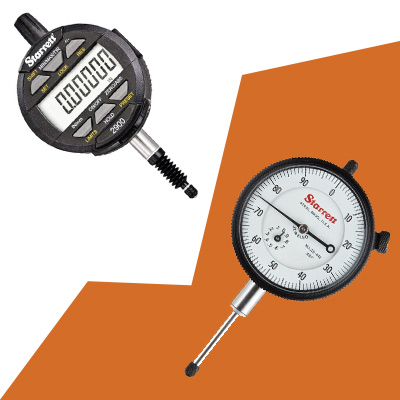When digital electronic indicators were introduced in the early 1980s, some observers expected them to blow mechanical dial indicators out of the water. In spite of electronic indicators’ clear superiority for use in statistical process control and data collection systems, mechanical indicators retain other advantages and they are still frequently specified by many sophisticated users. Neither type is “better” than the other: the choice depends upon the application and the user’s personal preference.
The clearest advantage of electronic indicators is in their use for data collection in process control. Electronic indicators can output measurements directly to printers or SPC programs with no operator errors in reading or recording. The operator only has to position the workpiece and press a button: he needn’t even read the measurement. With dial indicators, the operator must interpret the pointer’s position to read the measurement, then he must record it– generally by hand–and finally the data must be keyed into a computer. That makes three steps during which errors can and frequently do occur. In any situation, where data must be entered into a computer system, digital indicators are the only way to go. Of course, the user pays for this convenience: digital indicators usually cost significantly more than their mechanical counterparts.
Aside from the cost benefit, there is a great deal to be said for mechanical dial indicators. In many ways, the human brain is like an analog device, and it can often gather more information, more quickly, from an analog readout.
Remember how soundly the marketplace rejected digital speedometers in cars? When a measurement need only fall within a certain tolerance range, analog dials are often quicker and easier to read. An experienced gage operator can simply see whether the pointer is within tolerances without taking the time to actually read and interpret the numbers on the dial.
I have seen QC inspectors make consistently accurate go/no-go readings with dial indicators even before the pointer has stopped moving! They can tell at a glance approximately where the pointer will stop, and in many applications, that is close enough. Electronic indicators don’t give you the option of approximating. When a digital device is flickering between six and seven, all of the elements in an LCD display may be lit, appearing as an eight. See accompanying illustration.
Skilled operators can “split grads” with dial indicators, i.e., resolve the pointer’s position to an accuracy of about one-fifth of the gage’s stated minimum graduation value. And analog dials enable the machinist to observe the direction his process is headed. If reading #1 measures 1/5 of a grad over zero, reading #2 is precisely zero, and reading #3 is 1/5 of a grad below zero, the user may be able to draw valuable conclusions about the condition of his tool. In other words, dials can provide more information than simply the dimensional measurement. a digital readout would read zero in all three cases, depriving the user of this additional information. On the other hand, for statistical process control purposes, it is necessary to eliminate all such interpretive data, which again recommends the digital solution.
A common, serious problem among users of dial indicators is the failure to notice when the pointer makes a full revolution or two. Parts that are grossly out of tolerance may appear to be within tolerances to an inattentive operator. In contrast, digital indicators never come “back to zero,” eliminating this problem entirely. Furthermore, all digital indicators can be made to signal out-of-tolerance dimensions.
Many electronic indicators have some form of supplemental analog display. These electronic emulation’s of analog performance serve to eliminate some of the cognitive disadvantages of digital displays and make electronic indicators “user-friendly.”
In spite of initial doubts, electronic indicators have proven to be highly reliable in the shop floor environment. Most have only a single moving part, so they may require less frequent cleaning than their mechanical cousins. With proper care, however, dial indicators last forever, and they never need batteries.
Finally, there are somewhat broader ranges of accessories for mechanical indicators, and they are more readily customized for special applications–the subject of next month’s column.


